
* One of the interesting footnotes of the Mosquito story was its neat single-seat fighter derivative, the "DH.103 Hornet", that served in limited numbers in the postwar period. This chapter outlines the history of the Hornet, and also provides a variant summary for both the Mosquito and the Hornet.
* There were a number of proposals for Mosquito derivatives. In November 1941, DH proposed the "DH.99", later redesignated the "DH.101", fast heavy bomber to the Air Ministry. The DH.101 was apparently something like a scaled-up Mosquito that was to be powered by twin Napier Sabre 24-cylinder inline engines, used on the Hawker Typhoon, driving contra-rotating propellers. It was informally referred to as the "Sabre Mosquito".
The DH.101 was to carry a 7,260-kilogram (16,000-pound) bomb load to Berlin at a top speed of 692 KPH (430 MPH). However, the Sabre development program was troubled and DH was told they would have to make do with the Griffon, Rolls-Royce's next-generation successor to the Merlin. That configuration did not have clear advantages over the existing Mosquito, and so the idea was dropped in April 1942. The Air Ministry then tossed around the notion of an improved "DH.102 Mosquito II" with two-stage Merlins, but de Havilland couldn't come up with a design concept that was particularly exciting, and that line of investigation was dropped in turn at the end of 1942.
However, during 1942, DH had begun a private investigation of a single-seat fighter based on the Mosquito. The "DH.103 Hornet", as it would be known, was intended for the Pacific theater, where the great ocean spaces demanded long range, meaning a big fighter with a large fuel capacity. Air Ministry interest seemed muted and the DH.103 was shelved for a time, but excitement over the concept picked up in the spring of 1943, leading to an order for two prototypes in June 1943 under Specification "12/43".
The first prototype performed its initial flight on 28 July 1944, with Geoffrey de Havilland JR at the controls. The prototype was in the air only 13 months after the beginning of the detailed design effort. The first flight was troublesome -- the undercarriage didn't want to retract and the aircraft suffered from serious tail buffeting -- but the problems were worked out. Performance exceeded predictions, with a top speed of 780 KPH (485 MPH) and a blazing climb rate of 1,370 meters (4,500 feet) per minute. A production order followed.
As it emerged, the Hornet had an unmistakeable resemblance to the Mosquito, but was smaller and "sportier". The fuselage was built of wood in much the same way as the Mosquito, but the two-spar, one-piece, laminar-flow wing was of mixed construction, with a wood and metal internal structure, an undersurface of reinforced Alcad, and a birch-ply upper skin. The Hornet was the first aircraft to feature "wood bonded to metal" construction, using a new "Redux" adhesive.

The Hornet was powered by twin Rolls-Royce Merlins, which unlike the Merlins fitted to the Mosquito were "handed", with a "Merlin 130" on one side and a "Merlin 131" on the other, both rated at 1,515 kW (2,030 HP) and fitted with Hydromatic four-blade variable-pitch propellers. The engine radiators were fitted in the leading edge of the wings inboard of the engines. Like the Mosquito, the Hornet had taildragger landing gear, with the main gear retracting back into the engine nacelles and a semi-retractable tailwheel.
The fighter was armed with four 20-millimeter Hispano cannon, fitted under the nose. The pilot sat under a backwards-sliding bubble-type canopy. The second prototype and production aircraft were fitted for underwing stores, including two 909-liter (200 Imperial gallon / 240 US gallon) drop tanks; or two 450-kilogram (1,000-pound) bombs; or eight RPs; or two 225-kilogram (500-pound) bombs and four RPs. Since the production aircraft were fitted with operational kit, they were heavier and so slower than the prototypes -- but not by much, with a top speed of 760 KPH (472 MPH).
Production of the fighter began at de Havilland's Hatfield plant in late 1944, with the first "Hornet F.1" machines delivered to RAF Boscombe Down for pre-service evaluation on 28 February 1945. A total of 60 production F.1s was built. Early production machines demonstrated some longitudinal instability, leading to the fit of a forward tailfin fillet that was retrofitted to initial production. The dorsal fillet was retained in all other Hornet variants.
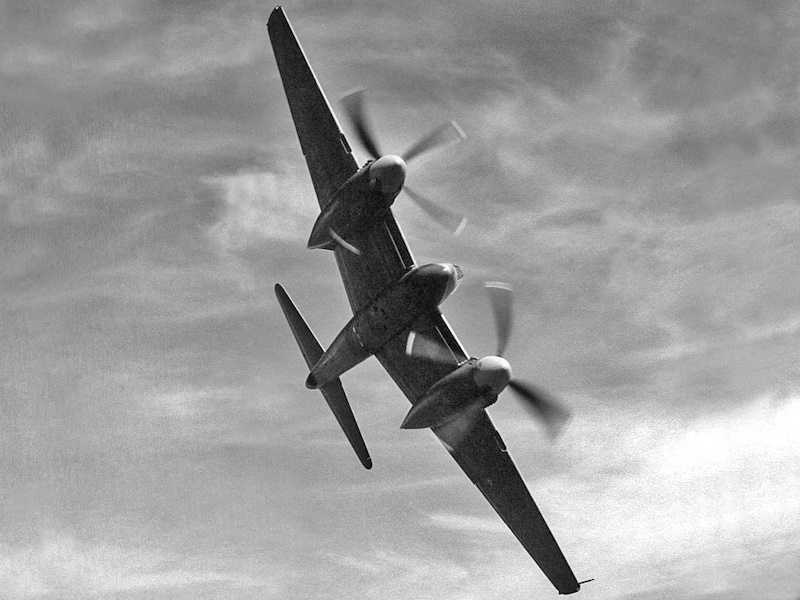
An unarmed photo-reconnaissance variant, the "Hornet PR.2", was considered, with three prototypes converted from F.1s and five evaluation aircraft built before a production order for 55 machines was canceled. A "Fighter Mark 3" Hornet did reach full production, with 121 built. This variant featured greater fuel capacity and a wider-span tailplane.
___________________________________________________________________
DE HAVILLAND HORNET F.3:
___________________________________________________________________
wingspan:
13.72 meters (45 feet)
wing area:
33.54 sq_meters (361 sq_feet)
length:
11.18 meters (36 feet 8 inches)
height:
4.32 meters (14 feet 2 inches)
empty weight:
5,842 kilograms (12,880 pounds)
loaded weight:
9,480 kilograms (20,900 pounds)
max speed at altitude:
760 KPH (470 MPH / 410 KT)
service ceiling:
10,670 meters (35,000 feet)
range with drop tanks:
5,635 kilometers (3,500 MI / 3,045 NMI)
___________________________________________________________________
Production of the F.3 was switched to the de Havilland plant at Chester in 1948. The last Hornets were built with an F.52 camera vertically mounted in the rear fuselage, with a fuel tank downsized to accommodate it. These machines were designated "Fighter-Reconnaissance Mark 4 (FR.4)"; 11 were converted from F.3s and 12 were built as new to end of production in 1951, after the construction of a total of 200 Hornets, including the two prototypes.
Most of the Mark 3s served in Malaya from 1950 to 1955 to deal with the Communist insurgency there. Their long endurance gave them substantial loiter time over target areas, and they were extremely accurate in cannon, bomb, and rocket strikes. They were phased out with regrets in 1955 due to spares shortages. The Hornet was the last RAF piston-powered fighter to see operational service.
BACK_TO_TOP* Even before the flight of the first Hornet prototype, de Havilland had been considering a carrier-based version for the FAA. In late 1944, under specification "N5/44", three early-production Hornet F.1s were modified to naval standards, with Heston Aircraft performing the design work.
The first Sea Hornet prototype flew on 19 April 1945. This machine had high-drag flaps, yoke-style arresting gear, tail-down catapult hookups, stronger landing gear, plus a navalized radio and other kit. The second prototype was similar, while the third prototype added wings that folded hydraulically upward outboard of the engine intakes. The third prototype began carrier trials on the HMS OCEAN on 10 August 1945.
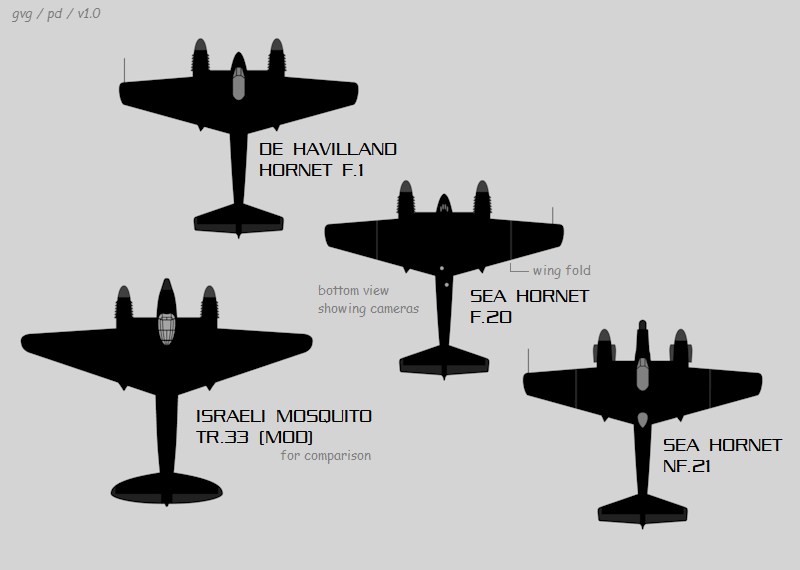
A production order for the "Sea Hornet F.20" followed. It was the Fleet Air Arm's first twin-engine, carrier-based fighter. It retained the four 20-millimeter Hispano cannon and underwing stores of its land-based cousin, though the FAA used half-size drop tanks, with a capacity of 455 liters (100 Imperial gallons / 120 US gallons). Dimensions were the same as for the Hornet, though the empty weight increased by about 250 kilograms (550 pounds). The only major difference in appearance from the Hornet was that the Sea Hornet had a camera port on each side of the rear fuselage for an optional oblique reconnaissance camera.
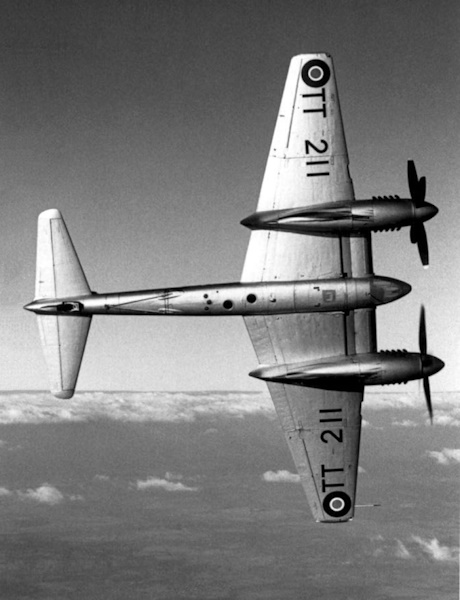
The Sea Hornet F.20 reached formal Royal Navy service in June 1947 with Number 801 Squadron, and a total of 79 was built. The type performed its first carrier cruise in 1949, on the HMS IMPLACABLE, and served in operational roles until 1951, when it was replaced by the Hawker Sea Fury. Some F.20s lingered in second-line roles until 1955.
* In late 1945, the Royal Navy came up with an urgent requirement for a carrier-based, two-seat night fighter, under specification "N.21/45". Heston Aircraft modified two Hornet F.3s to meet the specification, adding an ASH radar thimble in the nose, flame dampers on the exhausts, a small bubble-type canopy on the rear fuselage for a navigator / radar operator, and a larger tailplane assembly to compensate for the second canopy.
The result was the "Sea Hornet NF.21". It was slightly longer than the F.3 due to the thimble radome, and its empty weight was about a tonne more. Despite its role as a night fighter, it apparently could carry the same underwing offensive stores as other Hornets and Sea Hornets.
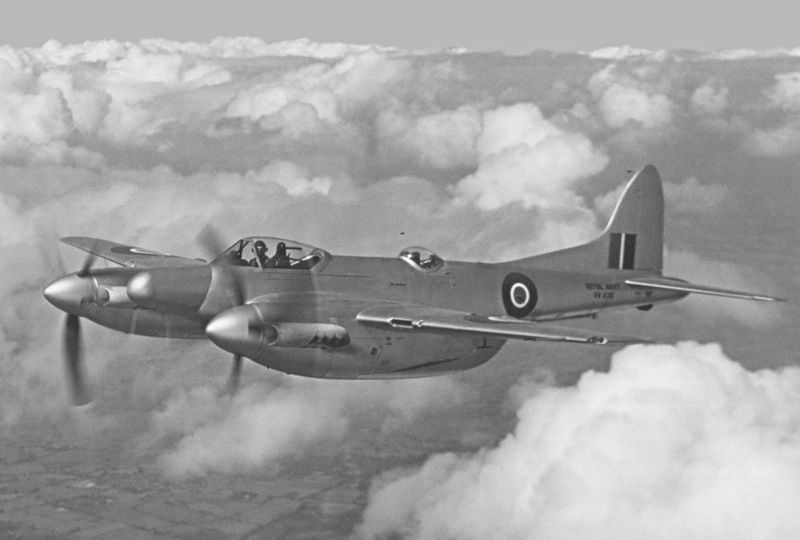
A total of 80 NF.21s was built. The NF.21 served as the standard FAA night fighter, operating off the carriers HMS VENGEANCE, INDOMITABLE, and EAGLE. It was also used to fly as a "formation leader" for groups of strike fighters. The NF.21 was replaced in operational service by the Sea Venom in 1954, lingering for another year in the radar training role.
The last Sea Hornet variant was the "PR.22" photo-reconnaissance machine, which was similar to the F.20, but featured either two F.52 cameras or a single Fairchild K.19B night-photography camera in the rear fuselage. The cannon were deleted, with the gun ports faired over. It could still carry underwing stores. Only 23 were built.
A total of 150 Sea Hornets was built to final end of production in 1951, for a grand total of 350 Hornets and Sea Hornets. Pilots found the type a joy to fly, like a "Grand Prix racer" as one pilot put it, but its wooden construction apparently didn't fare well under tropical conditions. Apparently no Hornet or Sea Hornet survives today, even as a static display.
BACK_TO_TOPGiven the large number of Mosquito and Hornet variants, it is useful to provide a summary list to keep them all straight. Reconnaissance variants included:
Bomber variants included:
Day fighter and night fighter variants include:
Fighter-bomber and naval variants included:
Trainers, target tugs, and so on:
Production totals:
Hornet & Sea Hornet variants included:
In addition to the two prototypes, 198 production Hornets and 150 Sea Hornets were built, for a total of 350 aircraft in all.
BACK_TO_TOP* While the Mosquito was one of the most prominent and successful aircraft of World War II, it also represented something of a missed opportunity. If it wasn't "too little and too late", it was "not as much as needed and not quite soon enough". It didn't really come into its own in terms of quantity and combat operations until early 1943, by which time the question was not if the Allies would win the war, only when.
Had the Air Ministry pushed the development of the aircraft, it might have been put into service earlier, and the course of the air war might have gone differently. Some have suggested that RAF Bomber Command might have been able to use fleets of low-flying Mosquitos for precision daylight bombing raids, with much greater destruction of specified targets, less misery to the German civilian population, and lower losses of men and material for the RAF. The might-have-beens are an interesting subject for speculation -- but history isn't a controlled experiment, and speculation is all that it is.
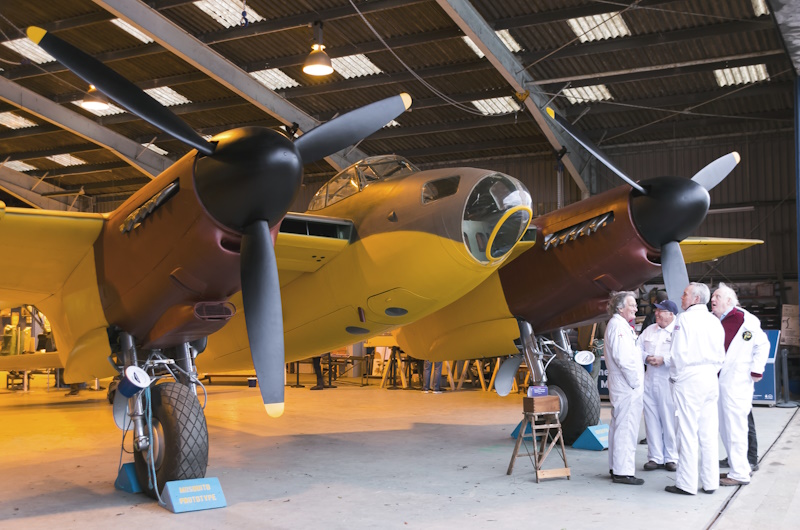
Although the Mosquito had a relatively long service life, the evolution of its design was modest, with final marks generally similar in appearance to early marks. It was quickly overtaken by jet-engine aircraft. However, for a few years the Mosquito was one of the most impressive aircraft in the sky.
* The production quantities listed for the Mosquito are "ballpark estimates". They can be regarded as of appropriate magnitude, but different sources give slightly different takes on the production quantities of different variants, and sorting through it gives a headache and no clear answer on exactly who to believe.
* Sources include:
* Illustration credits:
* Revision history:
v1.0.0 / 01 sep 02 v1.0.1 / 01 jul 03 / Minor cleanup and corrections. v1.0.2 / 01 jul 05 / Review & polish. v1.0.3 / 01 jun 07 / Review & polish. v1.0.4 / 01 may 09 / Review & polish. v1.0.5 / 01 apr 11 / Review & polish. v1.0.6 / 01 mar 13 / Review & polish. v1.0.7 / 01 feb 15 / Review & polish. v1.0.8 / 01 jan 17 / Review & polish. v1.0.9 / 01 dec 18 / Review & polish. v1.1.0 / 01 oct 20 / Review & polish. v2.0.0 / 01 sep 24 / Illustrations update, polish. (++)BACK_TO_TOP
